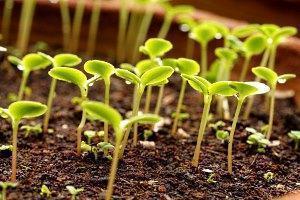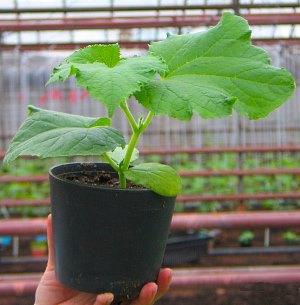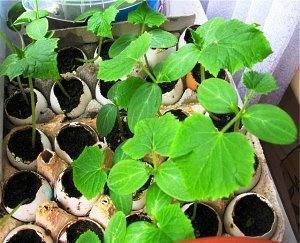Fertilizers for vegetable seedlings - types and recommendations of application
 When growing vegetables in a seedling way, it is necessary to use fertilizer for seedlings. Top dressing has a huge impact on plant growth, but adding additional nutrients requires some knowledge from the grower.
When growing vegetables in a seedling way, it is necessary to use fertilizer for seedlings. Top dressing has a huge impact on plant growth, but adding additional nutrients requires some knowledge from the grower.
When growing vegetables in seedlings, it is very important to choose not only high-quality seed material and priming , but also to apply the necessary fertilizers for seedlings in the development process. Experienced growers know that feeding has a huge effect on plant growth. However, this process requires compliance with the measure. Therefore, before fertilizing seedlings, it is necessary to select the type, shape and composition of the nutrient mixture.
Read also the article:ammonium nitrate application in gardening in autumn!
Mineral fertilizers for vegetable seedlings
Top dressing of this type consists of inorganic compounds, mainly mineral salts. Depending on the type of filling, fertilizers for seedlings are simple with one trace element or complex, containing several minerals.
The main minerals that are necessary for the full development of a plant:
- Nitrogen: ammonium nitrate (35% nitrogen), urea (46% nitrogen), ammonium sulfate (20% nitrogen), ammonia water (20-25% nitrogen).
- Phosphorus: superphosphate (20% phosphorus) or double superphosphate (40-50% phosphorus).
- Potassium: potassium chloride (50-60% potassium oxide), potassium salt (30-40% K20), potassium sulfate (45-50% K20).
With a lack of any mineral, seedling growth slows down significantly. Its leaves turn light green, become small and begin to fall off. With an excessive intake of mineral fertilizers, the plant can get burned and die. Therefore, before fertilizing the seedlings, you must carefully study the instructions and, in accordance with the declared norms, apply top dressing.
Organic fertilizers for vegetable seedlings
 This type of fertilizer contains organic matter. The main advantage of top dressing is that it contains not just one type of mineral, but almost all the necessary nutrients. Such an organic fertilizer cannot be attributed to any one type, since the main mineral elements are already present in it. In addition, other minerals are also contained in different proportions: cobalt, boron, copper, manganese, etc.
This type of fertilizer contains organic matter. The main advantage of top dressing is that it contains not just one type of mineral, but almost all the necessary nutrients. Such an organic fertilizer cannot be attributed to any one type, since the main mineral elements are already present in it. In addition, other minerals are also contained in different proportions: cobalt, boron, copper, manganese, etc.
Organic fertilizers for vegetable seedlings:
- Manure... The advantage of using manure is a complete set of all necessary substances. In addition, after its addition, the biological and physical characteristics of the soil are improved. It begins to release abundantly carbon dioxide, which is necessary for the carbon nourishment of the plant.
- Chicken droppings... Its distinguishing feature is its enormous productivity. It includes a large amount of nitrogen, potassium, phosphorus.
- Compost... This type of fertilizer is easily prepared at the summer cottage. For its preparation, leaves, straw, grass from weeds, potato tops, various kitchen garbage, etc. are used.
The introduction of organic fertilizers for seedlings gives a good result, but it can be difficult for a beginner to determine the required proportions. Therefore, before feeding, it is better to get additional advice from a specialist.
Fertilizer for cabbage seedlings
To get good cabbage seedlings
The second time fertilizer is applied two weeks before planting young seedlings in open ground. For this, 15 to 25 g of potassium sulfate and potassium chloride are diluted in a bucket of water (10 l). You can also add urea in the same amount. The resulting nutrient mixture in a warm form is applied under each plant at the rate of 1 liter per 5 plants.
Mineral fertilizer for cabbage seedlings can be replaced with organic ones. Cabbage seedlings show good growth after the introduction of poultry droppings.
One part of the droppings is filled with 2-3 parts of warm water and left for several days to infuse. The resulting solution is diluted with water 1:10 and fertilized.
Fertilizer for cucumber seedlings
Even if the seeds were sown in well-prepared soil, the plant still needs additional nutrition during the growth process. During the whole period growing seedlings of cucumbers feeding is done about two times.
The maximum absorption of nutrients by the plant can be achieved if fertilizer for cucumber seedlings is applied early in the morning on a warm sunny day.
 With the appearance of the first true leaves, the first feeding begins. For very small cucumber seedlings, it is better to use fertilizers in liquid form. To do this, dilute the mullein solution with water (1: 8), then water the young shoots with a nutrient mixture at room temperature. If a solution of chicken manure is used as a fertilizer for home seedlings of cucumbers, then it is diluted with water in a ratio of 1:10.
With the appearance of the first true leaves, the first feeding begins. For very small cucumber seedlings, it is better to use fertilizers in liquid form. To do this, dilute the mullein solution with water (1: 8), then water the young shoots with a nutrient mixture at room temperature. If a solution of chicken manure is used as a fertilizer for home seedlings of cucumbers, then it is diluted with water in a ratio of 1:10.
The second feeding is carried out a few days before planting young plants in open ground. In this case, it is necessary to prepare a solution of a nutrient mixture consisting of 10 liters of liquid, 10-15 g of urea, 15-20 g of potassium chloride or sulfate and 35-40 g superphosphate (instructions for use in the garden).
Fertilizers for tomato seedlings
In the process of growing tomato seedlings nutritious feeding is used several times. The first time fertilizers for tomato seedlings are used after picking only after 10 days. It is recommended to water the plants with organic fertilizers, which will enhance the growth of weak senses. The principle for preparing a mullein or poultry manure formula is described above.
Wood ash, which contains a large number of various trace elements, has also proven itself well as a fertilizer for home tomato seedlings.
 For 2-3 m² of sown area, 8-10 liters of liquid, 70-80 g of ash and 15-25 mg of ammonium nitrate will be required. This nutrient mixture can be used 10-13 days after the first fertilization.
For 2-3 m² of sown area, 8-10 liters of liquid, 70-80 g of ash and 15-25 mg of ammonium nitrate will be required. This nutrient mixture can be used 10-13 days after the first fertilization.
Each feeding of any plant should be completed with warm water irrigation. When applying fertilizers, avoid getting the fertilizer onto the leaf mass. To prevent the appearance of burns on the leaves after watering, it is recommended to sprinkle all plants with water.
Very good recommendations! Thank you for the article. Indeed, in order to get a good harvest, one cannot do without fertilization. I use saltpeter (15 mg per 10 liters of water) to feed a tomato. I dissolve saltpeter in water and add tomato bushes with this liquid, about 100 ml under each bush. This gives a good result, tomatoes grow faster, the leaves become darker. I have long wanted to try organic fertilizer, but I didn’t know the correct proportions. Now, after reading the article, I will definitely try.
How to feed pepper seedlings in pots at home and eggplant?
The article gives recommendations for seedlings of all vegetables.
Is it always necessary to feed seedlings?
We do not use any fertilizing for seedlings, as we grow them initially in a nutritious soil.
I believe that in this case, additional feeding will be unnecessary.
But after landing in the open ground, yes, you need to feed.